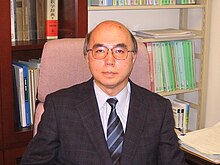Tōru Eguchi
Tōru Eguchi ( Japanese 江口 徹 , Eguchi Tōru ; in the Anglo-Saxon-speaking area also Tohru Eguchi; * February 2, 1948 , † January 30, 2019 ) was a Japanese theoretical physicist .
Life and career
Eguchi was a professor at Tokyo University . He was a professor at the Yukawa Institute for Theoretical Physics at the University of Kyoto , whose director he was temporarily (for example, 2009).
He dealt in particular with differential geometric methods in physics, with superstring theory , conformal field theories, topological quantum field theories, lattice range theories, quantum gravity and gravitation theories.
At the beginning of the 1980s he published a well-noticed and later much used review article on differential geometric methods in physics with Andrew J. Hanson and Peter Gilkey . They went into particular detail on physical applications and the representation of the Atiyah-Singer index sentence and related sentences. At that time he was at SLAC and the Enrico Fermi Institute at the University of Chicago .
With AJ Hanson in 1978 (at the time at SLAC) he found an exact, Euclidean instanton solution of the vacuum equations of general relativity, the Eguchi-Hanson metric. It also has applications, for example, in the construction of compactification manifolds in superstring theory.
With Hikaru Kawai he developed the Eguchi-Kawai model in lattice gauge theories with SU (N) gauge group for the limit value of large N. They showed that there the lattice gauge theory for infinite lattice and unit cube are identical and that this reduction also for the continuum -Transition of the grid can be maintained. In this limit case of large N, space-time is absorbed by the internal degrees of freedom .
In 1984 he received the Nishina Prize . In 2009 he received the Imperial Prize and the Prize of the Japanese Academy of Sciences .
Web links
References and comments
- ↑ 東 大 名誉 教授 の 江口 徹 さ ん 死去 素 粒子 論 研究. In: asahi.com . February 2, 2019, Retrieved February 2, 2019 (Japanese).
- ↑ a b 江口 徹 . In: デ ジ タ ル 版 日本人 名 大 辞典 + Plus at kotobank.jp. Retrieved July 7, 2012 (Japanese).
- ^ Eguchi, Gilkey, Hanson: Gravitation, Gauge Theories and Differential Geometry , Physics Reports, Volume 66, 1980, pp. 213-393, Online, pdf
- ↑ With a self-dual Riemann curvature tensor and with a positive-definite metric (i.e. not a Lorentz metric). It is not singular and Ricci-flat. Asymptotically it merges into a locally Euclidean four-dimensional space (ALE, asymptotically local euclidean). They are examples of non-compact four-dimensional hyper-Kahler manifolds.
- ^ Eguchi, Hanson Asymptotically flat selfdual solutions to Euclidean gravity , Phys. Lett. B, Vol. 74, 1978 pp. 249-251, Self-dual solutions to Euclidean Gravity , Annals of Physics, Vol. 120, 1979, pp. 82-106, Gravitational instantons , Gen. Relativity Gravitation, Volume 11, 1979, pp. 315-320
- ^ For example, Polchinski String Theory , Cambridge University Press, Volume 2, p. 309
- ^ Eguchi, Kawai Reduction of dynamical degrees of freedom in the large N gauge theory , Phys. Rev. Letters, Volume 48, 1982, p. 1063
- ↑ Represented, for example, in Yuri Makeenko Methods of contemporary gauge theory , Cambridge University Press, 2002, Chapter 14, Eguchi Kawai Model
- ↑ Y. Matsuo: Prof. Tohru Eguchi Receives Imperial Prize & Japan Academy Prize 2009. School of Science, the University of Tokyo, accessed on February 2, 2019 (English).
| personal data | |
|---|---|
| SURNAME | Eguchi, Tōru |
| ALTERNATIVE NAMES | 江口 徹 (Japanese); Eguchi, Tohru |
| BRIEF DESCRIPTION | Japanese physicist |
| DATE OF BIRTH | February 2, 1948 |
| DATE OF DEATH | January 30, 2019 |
